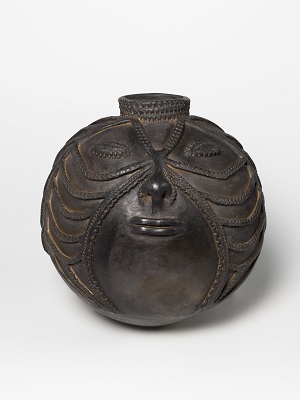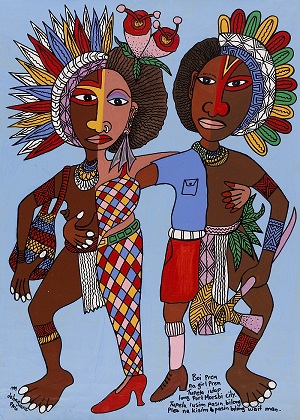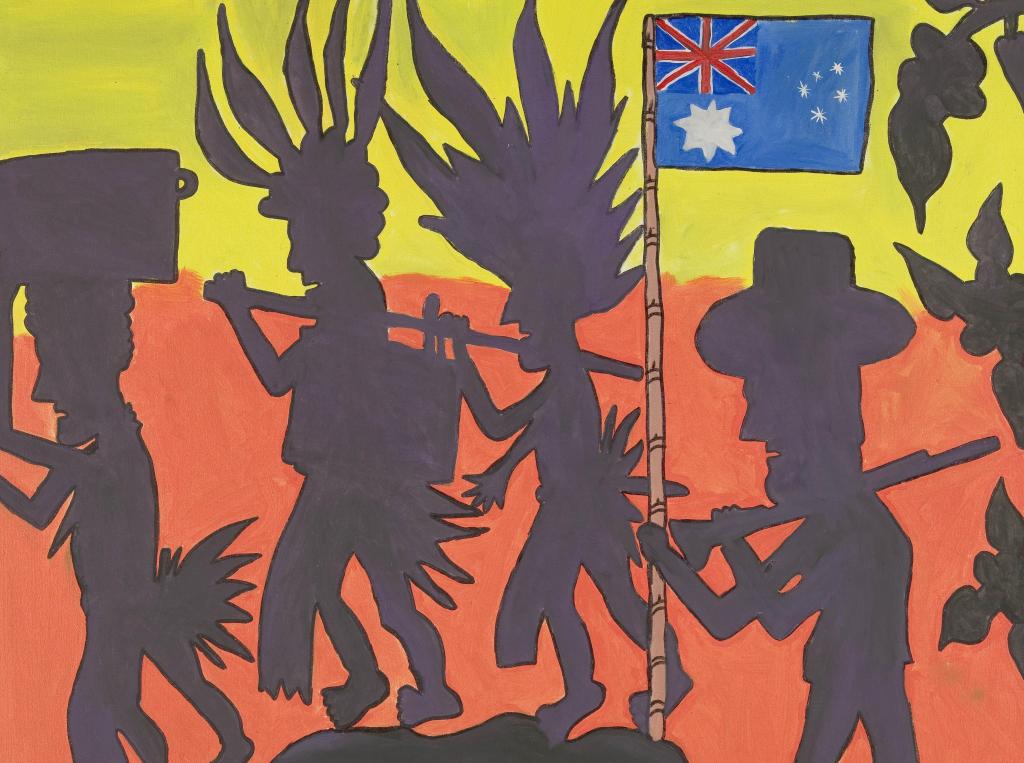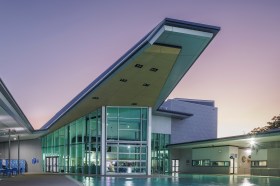Pictured: Simon Gende Papua New Guinea b.1969 Kuman people, Chimbu Province No 1 Kiap blong Australia Mr Jim Taylor I brukim bush long Highlands Papua Niugini (The first Australian Officer, Mr Jim Taylor, in an exploratory mission in the Highlands of Papua New Guinea) 1999 Synthetic polymer paint on canvas Purchased 1999. Queensland Art Gallery Foundation Grant. Thanks to QAGOMA.
NO.1 NEIGHBOUR, with its canny selection of objects from the QAGOMA collection and loaned works, reflects the benefits of The Queensland Art Gallery’s long-term commitment to its Asia Pacific Triennial program which has developed not only an expertise in the arts of near neighbours but an outstanding collection. Representing 50 years of complex, volatile cultural life in a single exhibition is a big ask and yet this show delivered and exceeded expectation.
Viewers approach No.1 NEIGHBOUR through a water hall populated with crocodiles (there were a LOT of crocodiles in this exhibition) created by the Yenchen group lead by Gibson Kapun, or via the towering Koromb (spirit house) originally created by Kwoma Arts, of the upper Sepik River, for the 7th Asia Pacific triennial of 2012. More subtly, the exhibition is book-ended by exquisite, modestly sized sculptures by Lucas Tangan (Adam and Eve, 2011) and Joseph Kandimbu (Commander Leo 2011).
This exhibition is substantial in scale but not as grand as some curated over the years in major galleries. The curators clearly wanted to illustrate surviving and revitalised practices, art made in response to political developments, the art of everyday life, and art which shows Papuans looking out from their borders at the world beyond. They certainly succeeded, because viewers left the gallery more educated and feeling a sense of engagement in this celebration of an exciting, evolving culture.
Talking of crocodiles, two outstanding examples are Puk puk (2016) by Ruki Fame, a welded steel sculpture depicting a chicken in the jaws of a metallic monster, and Puk puk (2011) by Angelina Andiboli Gumowe, a woven work which in its watchful stillness is just as threatening.

Joyce Mary Aresepa Gole ML Papua New Guinea b.1951 Orokaiva people, Oro Province Water storage pot – woman’s face 2013 Hand-thrown earthenware with incised decoration and beeswax Purchased 2015. Queensland Art Gallery | Gallery of Modern Art Foundation. Thanks to QAGOMA.
Ceramic works, textiles, costumes, and fabric objects are all represented. And for sure if the creators of bilums (shoulder bags) in this exhibition ever found better access to international markets they would soon be seen in trending global settings. Mambo, stand aside! Wendy Chouli’s work deserves more profile and recognition than she currently has.
Two works of special interest for an Australian audience are the Paramount Chief Headdress (c.1995) created by Graham Owari for Paul Keating to wear during his first official visit as Prime Minister and Simon Gende’s 2012 painted cloth work Leadership tussle in Australia: Rud V Gillard (sic). Both pieces conjure an enjoyable tongue-in- cheek amusement.
And some wonderful graphic works are neatly presented in museum frames. Tiabe’s screen-printed Accident, Helicopter, and Moto bagarap (motor crash (1968) and the prints of Mathias Kauage particularly stood out. Perhaps there’s an unavoidable tension between the power and energy in these images constrained, unavoidably, behind glass.
Taloi Havini’s Beroana (2015-16), a huge coil of shell money snaking into the sky beside the photographic works Middle Tailings, questions the extraction of natural resources for a cash economy and draws the viewer into the vortex of this impact.
For an Australian audience, the exhibition stimulates and is provocative because standing before many of the exhibits, particularly the more traditional items, it’s possible to appreciate the great skill and subtlety of creation whilst shut off from an in-depth understanding of meaning and broader implications. Ultimately, the triumph of No. 1 Neighbour is that it provokes a desire to know more about the aesthetic industry of our artistically highly skilled neighbours.

Pictured: John Siune Papua New Guinea 1965–2016 Kuman people, Chimbu Province Boi pren na girl Pren Tupela i stap long Port Morsbi city. Tupela lusim pasin bilong ples na kisim pasin bilong wait man (Boyfriend and girlfriend live in Port Moresby City. They leave traditional ways behind and take on whiteman style) 1999 Synthetic polymer paint on canvas Collection: Helen and Paul Dennett. Thanks to QAGOMA.
Rating: 5 stars out of 5
NO.1 NEIGHBOUR ART IN PAPUA NEW GUINEA 1966-2016
15 OCT 2016 – 29 JAN 2017
QAG | GALLERY 3 KENNETH & YASUKO MYER GALLERY, GALLERY 4, WATERMALL, WATERMALL WALL





